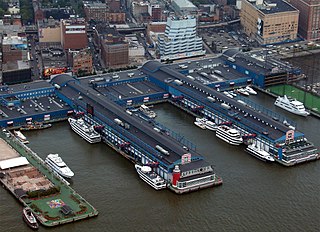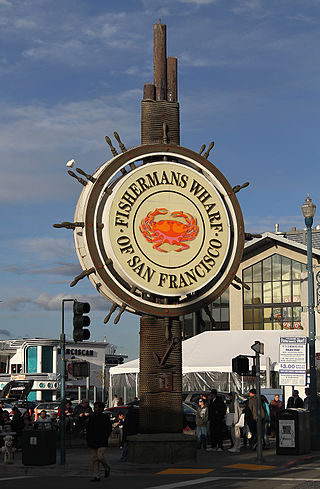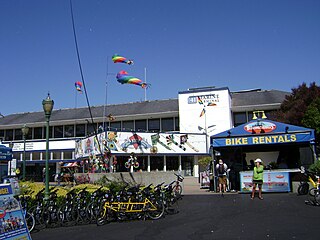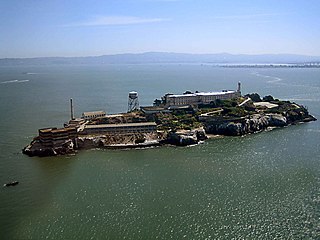
Alcatraz Island is a small island 1.25 miles (2.01 km) offshore from San Francisco, California, United States. The island was developed in the mid-19th century with facilities for a lighthouse, a military fortification, and a military prison. In 1934, the island was converted into a federal prison, Alcatraz Federal Penitentiary. The strong currents around the island and cold water temperatures made escape nearly impossible, and the prison became one of the most notorious in American history. The prison closed in 1963, and the island is now a major tourist attraction.

A pier is a raised structure that rises above a body of water and usually juts out from its shore, typically supported by piles or pillars, and provides above-water access to offshore areas. Frequent pier uses include fishing, boat docking and access for both passengers and cargo, and oceanside recreation. Bridges, buildings, and walkways may all be supported by architectural piers. Their open structure allows tides and currents to flow relatively unhindered, whereas the more solid foundations of a quay or the closely spaced piles of a wharf can act as a breakwater, and are consequently more liable to silting. Piers can range in size and complexity from a simple lightweight wooden structure to major structures extended over 1,600 m (5,200 ft). In American English, a pier may be synonymous with a dock.

Pier 39 is a shopping center and popular tourist attraction built on a pier in San Francisco, California. At Pier 39, there are shops, restaurants, a video arcade, street performances, the Aquarium of the Bay, virtual 3D rides, and views of California sea lions hauled out on docks on Pier 39's marina. A two-story carousel is one of the pier's more dominant features, although it is not directly visible from the street and sits towards the end of the pier. The family-oriented entertainment and presence of marine mammals make this a popular tourist location for families with kids.

Fisherman's Wharf is a neighborhood and popular tourist attraction in San Francisco, California. It roughly encompasses the northern waterfront area of San Francisco from Ghirardelli Square or Van Ness Avenue east to Pier 35 or Kearny Street. The F Market streetcar runs through the area, the Powell-Hyde cable car line runs to Aquatic Park, at the edge of Fisherman's Wharf, and the Powell-Mason cable car line runs a few blocks away.

East Brother Island Lighthouse is a lighthouse located on East Brother Island in San Rafael Bay, near the tip of Point San Pablo in Richmond, California. It marks the entrance to San Pablo Bay from San Francisco Bay.

The Port of San Francisco is a semi-independent organization that oversees the port facilities at San Francisco, California, United States. It is run by a five-member commission, appointed by the Mayor and approved by the Board of Supervisors. The Port is responsible for managing the larger waterfront area that extends from the anchorage of the Golden Gate Bridge, along the Marina district, all the way around the north and east shores of the city of San Francisco including Fisherman's Wharf and the Embarcadero, and southward to the city line just beyond Candlestick Point. In 1968 the State of California, via the California State Lands Commission for the State-operated San Francisco Port Authority, transferred its responsibilities for the Harbor of San Francisco waterfront to the City and County of San Francisco / San Francisco Harbor Commission through the Burton Act AB2649. All eligible State port authority employees had the option to become employees of the City and County of San Francisco to maintain consistent operation of the Port of San Francisco.

Pier 41 is a ferry terminal on Fisherman's Wharf in San Francisco. The former headquarters of Blue & Gold Fleet, their box offices are now located at Pier 39.
The General Frank M. Coxe was a steam ferry which was built for the United States Army to provide transportation services among several military facilities that ring California's San Francisco Bay. The Army port facilities, including the vessels, throughout the bay were under the command of the San Francisco Port of Embarkation from its establishment in May 1932 through World War II and the Korean War.

In June 1962, inmates Clarence Anglin, John Anglin, and Frank Morris escaped from Alcatraz Federal Penitentiary, a maximum-security prison located on Alcatraz Island in San Francisco Bay. Late on the night of June 11 or early morning of June 12, the three men tucked papier-mâché heads resembling their own likenesses into their beds, broke out of the main prison building via ventilation ducts and an unused utility corridor, and departed the island aboard an improvised inflatable raft to an uncertain fate. A fourth conspirator, Allen West, failed in his escape attempt and remained on the island.

Alcatraz water tower is on Alcatraz Island in the San Francisco Bay, off the coast of San Francisco, California. It is located on the northwestern side of the island, near Tower No. 3, beyond the Morgue and Recreation Yard. The water tank is situated on six cross-braced steel legs submerged in concrete foundations.

The Warden’s House was the home of the wardens of the federal penitentiary on Alcatraz Island, off San Francisco. It is located at the southeastern end of the Main Cellblock, next to Alcatraz Lighthouse. The 3-floor 15-room mansion was built in 1921 according to the Golden Gate National Recreational Area signpost, although some sources say it was built in 1926 or 1929 and had 17 or 18 rooms.

Building 64, also known as the Building #64 or the Building 64 Residential Apartments, was the first building constructed on the island of Alcatraz off the coast of San Francisco, USA, entirely for the purpose of accommodating the military officers and their families living on the island. Located next to the dock on the southeastern side of the island below the Warden's House, the three-story apartment block was built in 1905 on the site of a U.S. Army barracks which had been there from the 1860s. It functioned as the Military Guard Barracks from 1906 until 1933. One of its largest apartments in the southwest corner was known as the "Cow Palace" and a nearby alleyway was known as "Chinatown".

Fort Alcatraz was a United States Army coastal fortification on Alcatraz Island near the mouth of San Francisco Bay in California, part of the Third System of fixed fortifications, although very different from most other Third System works. Initially completed in 1859, it was also used for mustering and training recruits and new units for the Civil War from 1861 and began secondary use as a long-term military prison in 1868.

The General McPherson was a ship used by the U.S. military as a transport between military installations in the San Francisco Bay area. Named after Union General James Birdseye McPherson, a prominent figure in the American Civil War. The ship was the main mode of transport to Alcatraz Island during its function as a military defense and war camp after the ship was built in 1867. In addition to people is also carried military supplies and water. A time schedule dated 1885 shows that it traveled between San Francisco, Fort Mason, the Presidio, Alcatraz Island and Angel Island twice a day and took 20 minutes to travel between Camp Reynolds and Washington Street Wharf.

United States Penitentiary, Alcatraz Island, also known simply as Alcatraz or The Rock was a maximum security federal prison on Alcatraz Island, 1.25 miles (2.01 km) off the coast of San Francisco, California, United States, the site of a fort since the 1850s; the main prison building was built in 1910–1912 as a United States Army military prison.

Little Alcatraz is a small rock in San Francisco Bay roughly 81 yards (74 m) off the Model Industries Building off northwest coast of Alcatraz Island. Due to its proximity to the island it is known by this name, but it was formerly known as Paul Pry Rock due to the steamer Paul Pry striking it on December 22, 1862 with some 150 men on board. On January 14, 1868, the 700 ton British ship, Oliver Cutts, struck the rock and sank. Since it is submerged at high tides, Little Alcatraz is still routinely struck by small pleasure boats.

Ocean Wave was a steamboat that was operated from 1891 to 1897 on the Columbia River, from 1897 to 1899 on Puget Sound and from 1899 to 1911 as a ferry on San Francisco Bay. Ocean Wave is perhaps best known for transporting summer vacationers from Portland, Oregon to seaside resorts near Ilwaco, Washington during its service on the Columbia River. This vessel is also known for being the first ferry placed in service by the Atchison, Topeka and Santa Fe Railway.

The Ventura Pier, formerly known as the Ventura Wharf and the San Buenaventura Wharf, is a wooden pier located on the Pacific Ocean in Ventura, California. The pier has been designated as Ventura Historic Landmark No. 20. It is the oldest pier in California.

The Dolphin Club, also known as the Dolphin Swimming and Boating Club, is an athletic club in San Francisco, California. It caters to open water swimming, rowing, kayaking, stand up paddleboarding, and 4-wall handball.




















